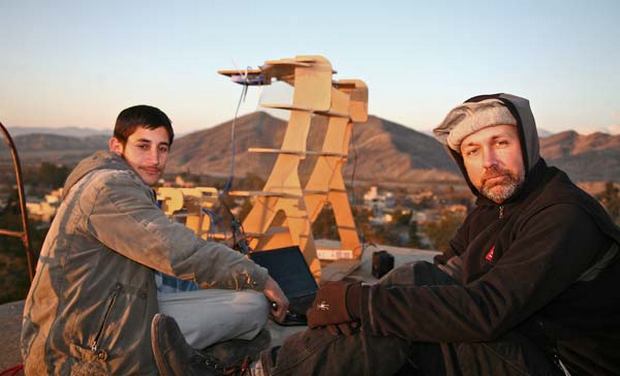The Afghan city of Jalalabad has a high-speed Internet network whose main components are built out of trash found locally. Aid workers, mostly from the United States, are using the provincial city in Afghanistan’s far east as a pilot site for a project called FabFi.
It’s a broadband apart from the covert, subversive “Internet in a suitcase” and stealth broadband networks being sponspored by the U.S., aimed at empowering dissidents, but the goal isn’t so different: bringing high-speed onilne access to the world’s most remote places.
Residents can build a FabFi node out of approximately $60 worth of everyday items such as boards, wires, plastic tubs, and cans that will serve a whole community at once. While it sounds like science fiction, FabFi could have important ramifications for entire swaths of the world that lack conventional broadband.
FabFi is an open source project that maintains close ties to MIT’s Fab Lab and the university’s Center for Bits and Atoms. At the moment, FabFi products are up and running in both Jalalabad and at three sites in Kenya, which collectively operate as an Internet service provider called JoinAfrica. Inside Afghanistan, FabFi networks are used to aid local businesses and to prop up community infrastructure such as hospitals and clinics.
FabFi is funded primarily by the personal savings of group members and a grant from the National Science Foundation.
The technology used to create FabFi networks seems like it leaped out of an episode of MacGyver. Commercial wireless routers are mounted on homemade RF reflectors covered with a metallic mesh surface. Another router-on-a-reflector is set up at a distance; the two routers then create an ad-hoc network that provides Internet access to a whole network of reflectors. The number of reflectors which can be integrated into the network is theoretically endless; FabFi’s network covers most of Jalalabad.
The reflectors can be built out of wood, metal, plastics, stone, clay, or any other locally available product that the metallic mesh can be attached to. FabFi also designed their devices to run on power generated by an automobile battery, which means the networks an also go “off-the-grid” if necessary.
Afghanistan is also a focal point for One Laptop Per Child (OLPC), which is currently working in Jalalabad, Kabul, Herat and Kandahar. OLPC’s Samuel Klein noted that locals are being introduced to Wikipedia for the first time, which resulted in an amazing image of an Afghan family viewing Wikipedia on OLPC laptops (right). Wikipedia has a robust Pashto-language version.
The director of the Jalalabad FabFi project, Amy Sun, says that Internet access is just one piece of the puzzle for Afghanistan:
Fab Lab/Fi doesn’t solve everything. It’s only one piece: the rest have to develop at the same time. Infrastructure like roads, power, water, schools, teachers, and systems maintenance as well as the user terminals (laptops and computers), people who use them, and the content they’ll consume. It’s crazy to think that there was no cell phone service in the country in 2002 and now it’s pretty solidly working in every major population center (at least when the tower isn’t turned off or bombed). From roads to power to water, the task at hand (officially U.S. or not) was to set off a program that could go from zero to servicing 30 million people in a few years. Imagine deciding to colonize Mars and sending 30 million people first, ahead of the infrastructure.
However, FabFi has brought a scaleable model of low-cost broadband Internet access to one of the most war-torn regions of the world. Networks of the type created by FabFi operate independently of government control and can be deployed by anyone anywhere where local infrastructure will not permit a conventional network. What works in Afghanistan can also work elsewhere.
[Images: Courtesy FabFi]

Cecily Sommers is the Founder & President of The Push Institute, a non‐profit think tank that tracks the ideas, technologies, and people that will, to quote its mission statement and push the future in new directions.
Cecily speaks, writes, and consults on the practical value of all that big thinking, particularly as it relates to building brand-specific, future-focused innovation portfolios. She is a semi-regular contributor to Public Radio’s All Things Considered , was named as one of “Twenty‐Five Women” to Watch by the Business Journal, and selected as one of Fast Company’s “2007 Fast 50 Reader’s Favorites.”










